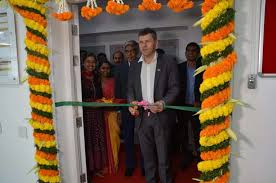In view of understand the cutting edge research that Indian academies have undertaken, Nikhil Kashyap, Correspondent from IndiaTechnologyNews met with Professors at IISC, Bangalore. Excerpts on the journey of the projects undertaken at universities and their engagement methods with entrepreneurs.
Part 1 of 2….
In a world being remade by technology, infrastructure is not the only indicator of economic growth. In one of his weekly addresses to the nation, President Obama once said “Those who out-educate us today will out-perform us tomorrow”. Knowledge creation in world class universities oriented towards solving real world problems, bears huge promise when combined with India’s burgeoning entrepreneurial stomach. The Robert Bosch Centre, situated in IISC Bangalore, is one such centre oriented towards exactly this. The centre focuses on four core areas, the most mature of which is healthcare:
Endoscopic Emulator – Though the centre boasts several patents and inventions, the most recent of these is an ‘endoscopic simulator’, an innovative way of training medical students on the usage of an endoscope. The endoscope is manoeuvred through an artificial environment representing the trachea tunnel, enabled with control feedback mechanisms to generate haptic feedback on contact. The centre is currently collaborating with private companies in order to integrate the physical system with a relevant graphical interface.
Neo-natal monitoring system – Neonates, i.e. new born babies, are heavily prone to hypothermia, which usually results in death. In order to prevent this, temperature monitoring systems in different areas transmit data back to a central station in Bangalore, where the information gathered is used to auto trigger warnings. Another envisaged use case are neo natal ICU’s, where the babies’ vital metrics are placed under constant observation through applications installed on nurse’s cell phones.
Smart Ring – The very nature of interdisciplinary research renders technologies applicable to completely different, and sometimes surprising, use cases as originally imagined. A smart ring, originally built to monitor movement patterns of patients recovering from surgery, is now finding utility in women safety. The ring can be easily facilitated with an option to send a distress signal to the carrier’s cell phone, which in turn immediately sends out an SOS call.
Amulet – When an accident occurs, the first half an hour is crucial to the victim’s life. Therefore, unbroken connectivity within an ambulance could potentially determine life or death. However, uninterrupted connectivity with a single service provider is nearly impossible due holes in network areas. ‘Amulet’ attempts to detect these holes and dynamically switch between service providers to provide steady video and audio links with the doctors in the hospital.
On a different note, much has been said about Prime Minister Narendra Modi’s Smart City Project. A flagship initiative at the Robert Bosch centre is the Smart Campus project, envisioned with the idea of validating some of the building blocks of a smart city at the campus level. Under the umbrella of this project are organized many verticals, one of which is Water Management. The most obvious utility is to use sensing technology to simultaneously avoid overflow and paucity of water in tanks. However, a simple upgrade of this technology to measure as opposed to simply detect, can result in actionable information on water usage per capita. Another far more crucial application is the measurement of water quality by using sensors that can detect the total dissolved solids in a sample of water.
However, automation of manual processes is not the only aspect of the smart campus project, or for that matter, the smart cities or any other initiative to improve standards of living. Proactive Crowdsourcing of important tasks and taking ownership of our living spaces is an important aspect as well. For example, water quality can easily be tested by citizens through pH test strips. The colour of the strip once dipped in water can be captured on a smart app and sent to control centres where this is translated into quantifiable metrics. This manner of working is a far cheaper means of achieving the same result, as sensing of chemicals in water can be an expensive arrangement. Another way of reducing costs is sacrificing accuracy for cheaper sensors, and using statistics and data analysis to plug in the gaps. Overall, such implementations also represent a sustainable mode of problem solving. In an Indian context, this mind-set of tackling issues is not a choice; it is simply a necessity. For unlike her western counterparts, India cannot create solutions by throwing money at her problems.
These methodologies also introduce additional components of complexity. The data analytics tool chain must now accommodate for some kind of stream processing mechanism to channel the data flowing through from different sources; in this instance, through thousands of sensors and crowdsourced inputs. The data coming in from these sources must be annotated and indexed so that it is science and domain ready. Analytics makes forecasting of demands possible, so that the water can be pumped up to requisite levels. Forecasting of shortages in supply is also useful, so that sufficient water can be stored in reservoirs for summer weeks where water is released sparingly. Analytical algorithms for on-the-fly detection of water quality issues is another noteworthy use case. For example, if the chlorine levels between two parts of a pipe drop, it is likely due to a contamination seeping through.
All of the above mentioned can be classified as production issues. They do not even begin to cover deployment complexities. In Indian rural and urban settings alike, 100% connectivity for real time streaming is not a valid assumption. However, since the information being stored is not time critical, piggybacking mechanisms become available; where data is stored and forwarded when possible. Maintenance of devices also plays a major role in ensuring the sanctity of the data being sent. The sheer amount of equipment needed to power a smart city, renders manual checking of device health out of the question. Using data intelligently can allow us to proactively detect sensor states. For example, a major skew in a particular sensor’s readings as compared to other’s in the neighbourhood, could be an indicator of imminent failure.
Similarly, reconfiguration of devices when additional sensors are introduced is also a moot point. All of these factors mean that devices need additional intelligence to scale to a deployment environment. The Robert Bosch Centre handles these issues by abstracting out complexities into middleware technology, which allows seamless plug and play mechanisms. The middleware technology essentially introduces a DNS (Domain Name Service) equivalent for IoT devices, so that when a new device is introduced a simple entry can be made in the registry for lookup. A good analogy for the same, would be a common registry of business cards or a glossary of sorts.
Source – itnbureau@gmail.com
Contd….






